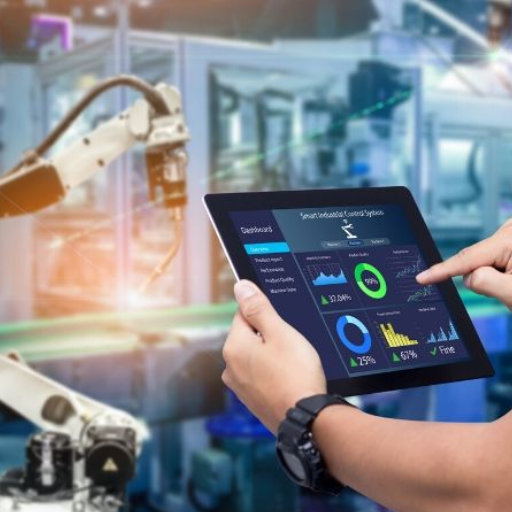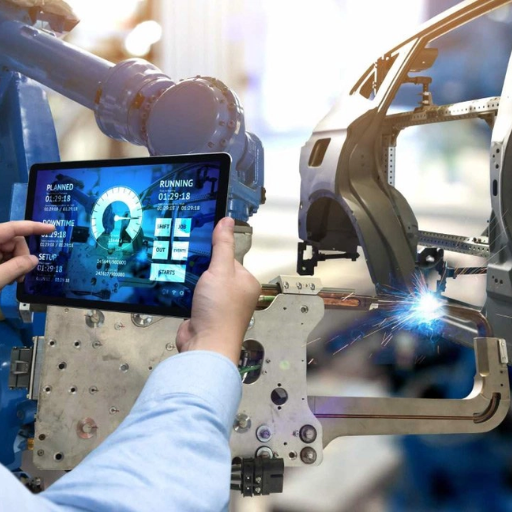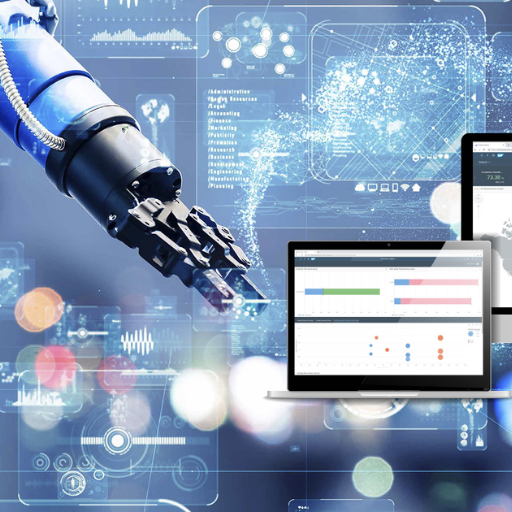What is Digital Manufacturing?

Image source: https://www.ptc.com/
Understanding Digital Manufacturing
Key Technologies in Digital Manufacturing
- Internet of Things (IoT): This entails a connection between different manufacturing devices and systems that allow real-time data collection and communication. Machine performance is tracked by sensors, actuators, and other connected devices keep track of inventory levels for effective operations. Connectivity also helps in the acquisition of actionable insights to help in optimizing production processes as well as quick response to any issues hence improving on operational efficiency while reducing costs.
- Artificial Intelligence (AI) and Machine Learning (ML): These algorithms analyze the massive amounts of data generated by IoT devices among other sources found within the manufacturing ecosystem. For instance, such technologies can predict equipment breakdowns, optimize maintenance intervals and enhance quality of products during manufacturing through detection of patterns and anomalies. Manufacturers are able to do this through utilization of AI/ML, which further enables them to carry out predictive maintenance thus minimizing downtimes, increasing precision levels thereby attaining high productivity rates.
- Cloud Computing: It also offers scalable computing resources for manufacturers to store huge datasets hence better processing ability. In addition, cloud technology allows information sharing across departments and geographical locations thus supporting collaboration and real time decision making. Moreover cloud-based platforms provide advanced analytic tools as well as machine learning capabilities that help manufacturers innovate continually in their operations.
The Evolution of the Manufacturing Process
The technological advancements have been a significant change in the history of manufacturing process. At first stage, Industrial Revolution brought mechanization and steam power that made it possible to multiply production tenfold. Henry Ford’s invention of assembly lines saw mass production become the norm thus increasing efficiency as well as standardization.
Manufacturing has also witnessed further transformations due to digital technologies in recent times. Smart manufacturing is facilitated by Industry 4.0, which involves integration of IoT, AI and cloud computing among others into production systems. These technologies enable real-time data analytics, predictive maintenance and increased operational efficiency. In addition, digital manufacturing optimizes processes leading to customization as well improved product quality.
How Does a Smart Factory Work?

The Role of IoT and Connectivity
The internet of things (IoT) and connectivity are very crucial in the operation of a smart factory. IoT devices such as sensors, actuators, and intelligent meters are embedded into machinery and production lines. These devices are continuously collecting and transmitting data about operating conditions, performance metrics, and environmental factors to a central system. Connectivity ensures that this information is securely transmitted and efficiently, often in real time.
A smart factory can use cloud computing and advanced data analytics to process massive amounts of information for actionable insights. Such insights enable predictive maintenance resulting in reduced instances of equipment failures or unscheduled downtime. Additionally, it allows for seamless communication between different machines and systems thereby promoting synchronization as well as optimization of workflows.
Real-Time Data and Analytics
Real-time data and analytics are, thus, a very important part of smart factories that empower businesses to decide faster. This enables the smart factory to identify patterns, predict potential issues and optimize production in real time by processing data as it is obtained. This cycle of immediate feedback enhances accuracy while minimizing waste and therefore improving resource utilization.
In such a scenario, leading industrialists demonstrate how predictive maintenance using real-time analytics gives them an edge in business; this minimizes losses from unscheduled downtime and extends the life span of equipment. Again, up-to-date information gained from real-time data ensures that there can be rapid changes made on production timetables as well as workflows necessary for prompt adaptation to market demands and operational shifts within the plant.
Ultimately, agile and resilient manufacturing processes are supported by real-time data plus analytics. This leads to continuous improvement and greater productivity overall with a better understanding of the production environment.
Improving Efficiency with Automation
Automation is important in improving how manufacturing works by simplifying processes and lessening the involvement of humans. Automation systems take up boring, repetitive chores from human workers thus enabling them to engage in more complex tasks that are also strategic. It improves productivity and reduces errors leading to higher quality outputs.
The importance of advanced robotics and automation systems has been covered extensively on top industry websites. These machines can perform better than human beings as they have precision and speed when executing tasks. Automated systems can be made to respond dynamically by employing machine learning techniques and artificial intelligence towards varying production needs.
In addition, automation facilitates real-time monitoring of production metrics so that immediate changes can be done to ensure operational efficiency in organizations. Automated systems provide comprehensive information about the process of production which helps uncover bottlenecks and opportunities for improvement. This way, resources are well managed and used efficiently hence minimizing downtime while maximizing throughput.
To summarize, embracing automation in manufacturing results in enhanced efficiency, reduced operating costs, improved quality of output; hence making it a central point for modern smart factories.
What Are the Benefits of Digital Transformation in Manufacturing?

Enhanced Productivity and Efficiency
Optimizing the Supply Chain and Workflow
To improve efficiency and cut expenses, it is necessary for manufacturers to focus on the optimization of supply chain and workflow. According to McKinsey & Company, Boston Consulting Group (BCG), and Gartner, some important strategies stand out.
One of them is based on deploying advanced analytics and real-time data which would enable manufactures have a full picture of their supply chains from start to finish thus identifying trouble spots and ensuring optimal levels of inventory. A good digital infrastructure which encompasses IoT sensors and cloud-based platforms should be implemented so as to promote instant communication between suppliers, producers, and customers. Henceforth, the faster adjustments in market situations and consumption patterns will be made possible through interconnectedness.
APS tools could also be employed to make use of AI technology to predict demand more accurately based on historical sales information and other factors that are likely to influence sales volume in the future as well as purchase raw materials just in time or maintain low stocks. By employing APS systems with AI-enabled algorithms for better predictions can help firms estimate demand more precisely, secure timely purchase order placements from suppliers as well as well-run production runs minimizing downtime periods.
The last pillar revolves around building strong ties with the suppliers therefore fostering a resilient supply chain for better performance. Manufacturers can work together with their suppliers closely such that they may share common problems relating both production processes, assume risks together or reap mutual benefits. Such collaborations lead allocation of resources between different facilities by improving innovation sharing among them.
When these strategies form part of a single digital transformation programme; manufacturers are able to respond dynamically depending on market needs while optimizing their operations for maximum output levels.
Cost Reduction and Resource Management
In order to achieve this, manufacturers need to adapt several measures. One of them is lean manufacturing which can significantly reduce wastages and increase efficiency generally. Manufacturing expenses are lowered by these activities through process simplification and removal of non-value-added activities.
Secondly, investing in energy-efficient technologies such as sustainability initiatives accrue substantial cost savings. This will include use of renewable sources of energy, optimizing on the consumption of energy and ensuring that emission levels are minimized hence reducing costs in addition to compliance with environmental regulations and customer expectations.
Thirdly, using advanced software applications like Enterprise Resource Planning (ERP) systems helps for better resource allocation and inventory control. Such systems provide real-time performance insights into utilization assisting manufacturers avoid overproduction while lowering inventory carrying costs.
Lastly, performing regular assessments alongside performance reviews facilitates continuous improvement. By looking at key performance indicators (KPIs) and identifying areas requiring change, firms may take necessary steps to improve resource efficiency by cutting down on costs. In summary, this comprehensive approach towards managing cost cuts and resources does not only enhance bottom-line but also long-term competitiveness as well as sustainability.
How Does Digital Twin Technology Impact Manufacturing?

Creating and Using Digital Twins
Several key steps are involved in creating and utilizing Digital Twins. The first entails collecting data from sensors and IoT devices on the physical asset or system to create an accurate virtual model. This model is continuously updated using real-time data to show any changes that happen at the physical copy. Consequently, by using advanced analytics and machine learning algorithms, manufacturers can simulate different scenarios and predict possible outcomes thereby revealing potential problems even before they arise.
In practice, Digital Twins can be used for predictive maintenance, optimizing production schedules, testing new processes and designs without interrupting actual operations. The insights offered by these digital models enable optimized resource utilization, better operational efficiency as well as reduced costs. Consequently, Digital Twins work as a vital tool towards the continuous drive of innovation and excellence in manufacturing industry.
Improving Product Design with Virtual Prototyping
Virtual prototyping uses contribute significantly towards ensuring quality standards are met and customer expectations are fulfilled by allowing teams to validate their ideas with utmost precision. Moreover, these digital models promote better cooperation among interested parties since they provide a transparent representation of design ideas. Therefore, virtual prototyping is seen as an influential method enhancing creativity, productivity as well as innovativeness in designing products.
Predictive Maintenance and Troubleshooting
Predictive maintenance is a system that employs data analytics, machine learning, and Internet of Things (IoT) sensors to continuously monitor the performance of equipment and predict its failure. If predictive maintenance systems can analyze real-time data from machines, they would recognize patterns or anomalies that indicate impending issues. As such being proactive approach allows companies to address problems during scheduled downtimes thus minimizing unplanned outages and reducing maintenance costs.
Several key benefits are associated with modern predictive maintenance solutions. They prevent catastrophic failures; therefore, they help in prolonging the life span of assets hence increase operational efficiency as well as enhance safety measures. Additionally, predictive maintenance enhances troubleshooting since it provides detailed diagnostics and insights for quicker and more accurate identification of root causes of issues.
The implementation of predictive maintenance involves integrating advanced technologies into existing systems as well as training staff to interpret data effectively and respond accordingly. As organizations adopt these innovative solutions, they should anticipate higher reliability and performance across their operations leading to increased productivity levels and cost savings on the whole.
What Challenges Do Manufacturers Face in Digital Transformation?

Cybersecurity and Data Privacy
For manufacturers undertaking digital transformation, Cybersecurity and data privacy are very important. A major point is making sure that strong security measures are put in place to guard against cyber threats on the sensitive information. This involves implementation of sophisticated encryptions systems, firewalls and regularly auditing for security flaws. Manufacturers should also impose strict access controls together with authenticating protocols so that only authorized individuals can have entry into critical systems.
Data privacy entails handling personal and confidential information within the framework of regulatory stipulations such as GDPR and CCPA. Manufacturers need to ensure that data is collected, processed, and stored securely and privacy rights of individuals are respected. Further, setting up comprehensive data governance policies helps in compliance adherence as well as ensures clearness in utilization of data.
Ultimately, during this journey of digital transformation; strong cybersecurity measures combined with extensive data privacy practices help protect against potential attacks while building customers’ trust with stakeholders.
Integration with Traditional Manufacturing Systems
It is a process of integrating digital technologies with traditional manufacturing systems that requires careful planning and execution. Firstly, manufacturers should evaluate their existing infrastructure to identify areas where digital solutions can seamlessly blend with conventional methods. Technologies like IoT, AI, and machine learning can be incorporated into legacy systems to enhance operational efficiency and productivity.
Secondly, interoperability is critical. Ensuring that new digital tools can communicate effectively with existing machinery and systems is essential to avoid disruptions. Implementing standardized communication protocols and employing middleware solutions can aid in achieving smooth integration.
Lastly, employee training and change management play pivotal roles. Workers need to be educated on new technologies and workflows to fully leverage the benefits of integrated systems. By fostering a culture of continuous learning and adaptation, manufacturers can ensure a more cohesive and efficient transition towards digital transformation while maintaining the strengths of their traditional manufacturing systems
Adapting to Rapid Technological Changes
In order to adjust rapidly and efficiently to ongoing technological changes, an active and strategic approach is necessary. For a start, the manufacturers should stay updated on emerging technologies and industry trends by constantly monitoring the market as well as engaging with technological experts. This can be made possible through partnerships with technology providers; industry conferences attendance, subscribing to relevant publications.
Secondly, agile methodologies may also help organizations move faster in relation to technology. By taking an iterative approach towards development and implementation, manufacturers could try out new technologies on a small scale before broad deployment thereby reducing risks and facilitating a smooth transition.
Lastly, it is crucial for organizations to create an innovative culture. Encouraging employees to think outside of the box while contributing ideas that integrate new technologies can foster continuous improvement. When there are regular trainings and skill development programs, the workforce will be well equipped with capabilities that relate to operationalizing new tools or processes so as maintain its competitive edge in a fast-changing landscape.
Manufacturers who are informed, agile in their practices and cultivate an innovative culture can easily adjust themselves in line with rapid technological changes thus remaining sustainable in an ever evolving industrial environment.
How to Implement Digital Manufacturing Technologies?

Digital manufacturing technologies incorporate a number of steps. Initially, businesses should do a very intense evaluation of the existing manufacturing processes to determine areas that can be most affected by this digital transformation. Next, choose the right digital tools and technologies that are in line with the needs and objectives of the organization. These may include IoT devices, AI-driven analytics or automation solutions.
After choosing the technology, a clear implementation plan should be developed. This will provide details about the timeline, budget allocation issues, responsibilities as well as key performance indicators (KPIs) for evaluating progress in relation to what was proposed at first. It is important to involve stakeholders from all levels of company management to ensure that everyone is on board so as to make sure success of the whole process of transformation.
Training and upskilling staff remains essential in order for them to use new technologies competently. Continuous learning opportunities together with hands-on training can ease acceptance and incorporation of digital tools that will be in place.
Moreover, starting with a pilot project enables small-scale testing of these new technologies before they are fully rolled out. Checking how this pilot test has gone helps when finetuning an implementation strategy.
Lastly, there must also be ongoing monitoring and optimization of digital manufacturing systems. There should regularly be updates which include reviewing digital technology so as not be left behind by industry developments or changing business requirements. Through these steps, manufacturers would successfully actualize their intentions on acquisition of digital manufacturing technologies thus increasing their operational efficiency state-wise at considerable margins.
Assessing Current Capabilities and Future Needs
To evaluate the current state of the organization and understand future requirements, one must have a good grasp of its present procedures, technologies, as well as skills of its staff. To get started, it is necessary to undertake an extensive review that ought to identify strengths and weaknesses alongside any areas that require improvement. As a result, this audit should evaluate current technological infrastructure, data handling practices within the organization and employee skills. Moreover, involve chief stakeholders to get their perspectives and anticipations towards digitalization.
Compare these findings against industry norms or best practices. This comparison will help to determine gaps in service delivery as well as opportunities for improvement. In particular, SWOT analysis can be very useful at this stage by enabling organizations to strategically plan their digital initiatives.
Lastly, project future needs by analyzing market trends, emerging technologies and competitive landscapes in order to prepare a road map for the coming years on what has been projected. A forward-looking roadmap ensures that businesses are evolving in tandem with the changing times thus maintaining competitiveness throughout such dynamic business environment of digital economy. It is mandatory therefore that both current capabilities as well anticipated needs are reviewed regularly so that they remain consistent with growing corporate objectives and changes related to 21st century technology revolution.
Choosing the Right Digital Manufacturing Tools
To choose the best digital manufacturing tool, focus on those tools that are consistent with your operation objectives and capabilities. Start by looking at devices that can be integrated well into your existing technology stack. It should be remembered that a device with strong data analytics and real-time monitoring capabilities will improve decision making as well as process optimization.
Go for IOT (internet of things) platforms that specialize in advanced robotics to enhance automation and efficiency. A good example is the one which allows a seamless connection between different manufacturing components through IOT or increase precision while lowering human errors in advanced robotic tools.
Ensure that the product is adequately flexible, scalable and adaptable to future growth and innovation. These may involve cloud-based solutions allowing easy scalability and updating to keep up with technological developments in your manufacturing processes.
Finally, prioritize software applications that have a user-friendly interface, as well as those whose customers receive great technical support when they need it. Ensure you have efficient training programs to help users quickly adapt new products into their operational systems so as to enhance productivity hence sustainability through maintaining competitive advantage.
Collaborating with Technology Partners
Associating with technology partners can bring immense worth in the digital manufacturing field. Therefore, they possess informed knowledge and perceptions that can be useful in speeding up the process of introducing and optimizing new systems. They also have reach to the most sophisticated tools and technologies that could be uneconomical to develop onsite. Furthermore, these alliances may promote innovation, giving businesses a competitive advantage by embedding cutting edge technologies like AI, machine learning and big data analytics into your production processes.
To ensure matching of particular operational requirements and growth goals, it is important to choose partners who have already proved their expertise in your field. It’s important that there is effective communication among members of this partnership besides roles’ definition as everybody works towards achieving common objectives and continuous enhancement. Consequently, regular evaluation of performance within the business is vital for maintaining its direction while ensuring continued success throughout.
Reference sources
- Article – “How Digital Transformation is Revolutionizing Industry 4.0 in Manufacturing”
-
-
- Summary: This article discusses how the integration of physical and digital technologies, known as Industry 4.0, is transforming manufacturing. It highlights the benefits and advancements achieved through smart factory implementations.
- Read more
-
Blog Post – “5 Proven Technology Trends For Your Digital Factory”
- Summary: This blog post examines five key technology trends that are shaping the future of digital factories and revolutionizing the manufacturing industry. It provides detailed insights into each technology and its impact on production processes.
- Read more
-
Sponsored Article – “Revolutionizing Manufacturing with Generative AI and Digital Twins”
- Summary: This sponsored article explores how digital transformation, particularly through generative AI and digital twins, is changing the landscape of manufacturing. It includes data on executive investments and partnerships driving these innovations.
- Read more
-
Frequently Asked Questions (FAQs)
Q: What is digital manufacturing technology?
A: Digital manufacturing technology involves using computer systems and software to enhance the manufacturing processes. This method integrates production design, simulation software, and chain management to streamline operations and improve efficiency.
Q: How does a digital manufacturer improve time to market?
A: A digital manufacturer uses data and business intelligence to optimize processes, thereby reducing production time. This approach significantly shortens the development cycle, enabling companies to bring products to market faster.
Q: What role does robotics play in digital manufacturing?
A: Robotics plays a crucial role by automating repetitive tasks on the factory floor. This technology not only improves labor productivity but also increases precision and efficiency, meeting varied customer needs.
Q: How can manufacturers use data to enhance their operations?
A: By leveraging data analytics and business intelligence, manufacturers can identify inefficiencies and optimize their approach to manufacturing. Data is used to improve decision-making, streamline production, and unlock higher levels of productivity.
Q: What is Industry 4.0 and how does it relate to digital manufacturing?
A: Industry 4.0 refers to the fourth industrial revolution, characterized by the integration of cyber-physical systems, IoT, and big data in manufacturing. Digital manufacturing aligns with Industry 4.0 by incorporating advanced technologies to enhance the manufacturing facilities’ capabilities.
Q: How does digital manufacturing impact the factory floor?
A: Digital manufacturing transforms the factory floor by integrating advanced technologies like robotics, computer-aided design, and real-time data monitoring. This results in a more streamlined and efficient production process.
Q: What is the importance of chain management in digital manufacturing?
A: Chain management is essential in digital manufacturing for optimizing the entire supply chain. An integrated approach ensures that every step, from raw material procurement to product delivery, is efficiently managed to meet customer needs and reduce costs.
Q: How can simulation software benefit manufacturing facilities?
A: Simulation software allows manufacturers to create digital models of their production processes. This helps in predicting outcomes, identifying potential issues, and making informed decisions to enhance productivity and reduce waste.
Q: What are some examples of companies leveraging digital manufacturing?
A: Companies like Siemens are leading the way in digital manufacturing. Siemens uses an integrated approach to manufacturing that connects various stages of production using advanced digital tools, significantly improving efficiency and reducing time to market.
Q: How does digital manufacturing address varying customer needs?
A: Digital manufacturing enables a customizable approach to production, allowing manufacturers to quickly adjust to specific customer requirements. This flexibility is achieved through the use of advanced data analytics, simulation software, and robotics.






